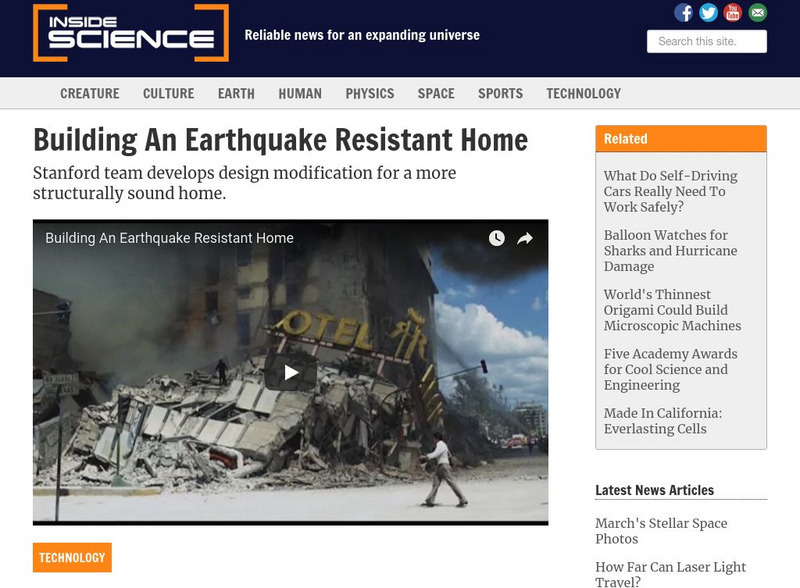Science Buddies
Science Buddies: Set Your Table for a Sweet and Sticky Earthquake Shake
Earthquakes can have different affects depending on their location. This week long exercise asks you to build a model house and a special table to shake it on, and see how different soil types can amplify shaking.
Other
Inside Science: Building an Earthquake Resistant Home
Engineers at Stanford University have designed a building that sits on a seismic isolator and is earthquake-resistant. When an actual house was tested on a shake table with a powerful earthquake simulation, the structure itself was...
Ducksters
Ducksters: Kids Science: Periodic Table of Elements
Kid's learn about the science of the Periodic Table of Elements. Groups and periods, atomic number, types of matter.
Science Struck
Science Struck: Periodic Table With Atomic Mass
Explains how Dmitri Mendeleev created the periodic table of elements, how it was organized, the changes made by Henry Moseley in 1931, some characteristics of element groups, and what the atomic mass, number, and abbreviation each...
Society for Science and the Public
Science News for Students: Heaviest Named Element Is Official
Describes the discovery and naming of copernicum, the heaviest element on the Periodic Table, named after the 16th century scientist Nicolaus Copernicus.
Science Struck
Science Struck: The Versatile Uses of Metalloids
Learn about the seven metalloid elements of the periodic table, their properties, and their uses.
Science Struck
Science Struck: Uses of Alkali Metals
Lists the properties of the alkali metal group of the periodic table and describes each of the six elements and their uses.
Society for Science and the Public
Science News for Students: The Newest Elements Finally Have Names
Nihonium? Tennessine? These aren't body parts or medicines. They're among the names just given to the four newest superheavy elements.
Science Struck
Science Struck: Meaning and Examples of Converse Statements
Explains the how a converse statement differs from an inverse statement, how to write a converse statement, and gives some examples of converse statements.
Science Struck
Science Struck: Properties and Characteristics of Chalcogens
Describes the chemical and physical properties of the chalcogen group of elements, also known as the oxygen group.
Science Struck
Science Struck: List of European Capital Cities With Countries
Discusses the geography of Europe and presents a table of 51 European countries and their capitals and a second table of 12 autonomous regions and their capitals.
Science Struck
Science Struck: Wavelength of Light
Describes the characteristics of light, presents two formulas for calculating its wavelength, and provides a table of the different wavelength ranges across the electromagnetic spectrum.
Science Struck
Science Struck: Liquid Measurements Chart
Provides tables showing how to convert liquid measurements used for cooking and for container labeling. Covers teaspoons up to gallons, as well as conversions to milliliters. Also explains the differences between British and American...
Science Struck
Science Struck: Barometer Units
Explains the different measurement units that are used in barometers and provides conversion tables.
Better Lesson
Better Lesson: Constant Speed
Students will connect math and science while working with constant speed. This lesson includes several constant speed problems that can be modeled with ratio tables. Included is a detailed plan, video explanation, slides containing notes...
Ducksters
Ducksters: Chemistry for Kids: Elements Transition Metals
Kids learn about the transition metals of the periodic table. Which elements are in this group. Properties, similarities, and other facts.
US Geological Survey
Earth's Water: Rivers and Streams
The USGS explains the definition of a river and how a river is supplied with water. Included is a cross section of a river. Click Home to access the site in Spanish.
Ducksters
Ducksters: Chemistry for Kids: Elements: Lanthanides and Actinides
Kids learn about the lanthanides and actinides of the periodic table. Find out which elements are in this group. properties, similarities, and other facts on this site.
Other popular searches
- Science Data Tables
- Reading Tables Science
- Making Tables Science
- Periodic Tables Science
- Input/output Tables Science







